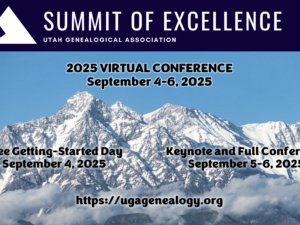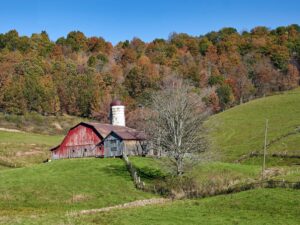All Aboard! Passenger Travel and Commerce on the US Railroads (1826-1945)
- Description
- Curriculum
Have you ever wondered what it was like to cross the U.S. or Canada by train in the 19th and 20th centuries? Whether riding in coach or a luxury sleeper, train travel shaped migration, business, and our ancestors’ everyday lives. The year 2026 marks the bicentennial of the first “iron horse!”
Railroads revolutionized travel—for business, relocation, or pleasure—transforming emigrants’ journeys that once took months by wagon or stagecoach into a few days. By the mid-1800s, railroads connected rural territories to major cities, offering new opportunities, while also presenting dangers. Perhaps your ancestor witnessed a train robbery, an accident, or observed the construction of rail lines near their property.
Beyond passengers, railroads played a vital role in commerce. Did your ancestor own a farm, lumber yard, or a factory? Even if they never rode a train, their goods—coal, wheat, dairy products, livestock, or timber—may have traveled across counties or states by freight rail.
This course’s sessions are divided into four themes:
1. Great Expectations – Meet the railroad barons who built empires, enticed emigrants with land offers, and fueled urban growth. Explore railroad stocks, the rise of boomtowns, and innovations that made train travel faster and more efficient.
2. Doing Business – Follow the freight! Learn how railroads influenced agriculture, industry, and commerce. Learn about the economic impact of railroads through analysis of land records. We will follow shipping routes on maps use gazetteers, examine waybills and receipts, and discuss the roles of farmers, business owners, and even the U.S. Post Office in the success of the railroads.
3. Riding the Rails – Explore the passenger experience, from ticket agents to luxury cars and emigrant trains. You may discover that your ancestor bore witness to a train robbery or railroad accident. Was your ancestor in the U.S. military? Find out how soldiers and equipment traveled by rail during the Civil War, and the railroad’s impact on the U.S. economy during WWI and WWII. Case studies will illustrate how these experiences can enhance your genealogical research.
4. Routes and Records – Uncover migration patterns using land records, maps, gazetteers, and census data. While passenger lists are rare, railroad companies left behind a wealth of records—broadsides, newspaper ads and articles, and railroad ticket stubs. If our ancestors crossed U.S. borders on trains, that information often appears on U.S. immigration documents. We will use the diaries, journals, letters, and memoirs of travelers to help bring our ancestors’ journeys to life.
The course concludes with “Write on Time,” a session dedicated to applying research strategies to enrich family narratives. Whether your ancestors were passengers or business owners shipping freight, All Aboard! will help you tell their tales from the rails.
Week 1, 9 February
Great Expectations: Railways, Roadways, Waterways, and Right-of-Ways, 9:30-10:45
Explore the rise of U.S. railroads from horse-drawn origins to steam power, inspired by federal support and entrepreneurial vision. Learn how rail lines connected communities, fueled settlement, and attracted investors. Discover how ancestors may have connected, worked near, or profited from this growing network alongside canals, stagecoaches, and rivers in early industrial America.
Doing Business: Shipping by Freight Train – Animals, Agriculture, & Industry, 11:15-12:30
By the 1840s, freight rail reshaped agriculture and industry. Livestock rode in stock cars, while towns near rail lines flourished with mills, depots, and warehouses. This session shows how waybills and maps reveal ancestors’ roles in farming, mining, and other commercial industries—and how freight access influenced their prosperity.
Week 2, 16 February
Riding the Rails: Pale Riders on Iron Horses, 9:30-10:45
Steam train travel in the mid-1800s was thrilling, risky, and controversial. Passengers—from elite investors to wary farmers—faced speed, uncertainty, and new social landscapes. We’ll explore cultural reactions to early rail travel and offer tips for locating passenger mentions in newspapers and guidebooks.
Routes & Records: Navigating Through New England & the Mid-Atlantic, 11:15-12:30
Instructor: Annette Burke Lyttle
Using early maps, newspapers, and gazetteers, we’ll trace how ancestors navigated the evolving transport networks and made decisions about where to travel, settle, or invest during the 1840s and 1850s. In this session, we’ll identify major repositories for maps and gazetteers to use in the hands-on session.
Week 3, 23 Feburary
Great Expectations: The Other Side of the Tracks, 9:30-10:45
Railroads weren’t just built—they were bought, sold, and marketed. This session examines how landowners and rail companies shaped migration by selling opportunities to emigrants. Learn how competition for land and settlers among the companies transformed regions.
Doing Business: The Emigrant Express and the Fate of Freight, 11:15-12:30
Before rail travel “classes” of travel, the “Emigrant Express” offered a basic but vital route west. Blending freight and passenger service, these trains connected people, goods, and merchandise, like gold. Explore how early networks moved commerce and migrants, including the role of enslaved labor and methods of shipping in both Northern and Southern economies.
Week 4, 2 March
Riding the Rails: Heading West & Crossing the Great Plains, 9:30-10:45
Thousands of immigrants arrived at Eastern ports, then boarded trains toward the Great Plains. This session examines westward rail travel’s role in displacing Native peoples, transforming cities like Chicago, and shaping rural expansion and growth of industries. Learn how to trace ancestors who rode the trains or used these expanding lines for business.
Routes & Records: Connecting at the Hubs, 11:15-12:30
As the Midwest became the launchpad for westward migration, personal diaries and maps captured travelers’ hopes and hardships. We’ll explore how bird’s-eye maps and freight records can help uncover the journeys of settlers and entrepreneurs pushing into areas and new states, such as Utah, California, and New Mexico, by rail.
No class on Monday, March9, following RootsTech
Week 5, 16 March
Great Expectations: Westward Ho! Land Grants, 9:30-10:45
This session explores how the U.S. government awarded millions of acres to rail companies via land grants, encouraging settlement and speculation. Learn how settlers and investors used rail-affiliated land to build futures—and repositories where historical land records are located.
Doing Business: Mail Trains, Cattle Cars, & Shipping Produce, 11:15-12:30
Railroads revolutionized rural business, from delivering mail to transporting cattle, corn, and household goods. This session uncovers how farmers used private lines and fought freight costs—and how freight manifests and shipping records reveal the economic ties between rail and everyday life.
Week 6, 23 March
Riding the Rails: Panama, Pullman Cars, and the Civil War, 9:30-10:45
Railroads became lifelines during the Civil War, moving troops, supplies, and the wounded. Discover innovations like hospital cars, Pullman cars, Pacific transit routes, and how railroads affected military strategy. We’ll explore dramatic rail disasters, wartime logistics, and how to find Civil War-era passenger and military transport records.
Routes & Records: Laying Tracks – Civil War Maps & Gazetteers, 11:15-12:30
Instructor: Annette Burke Lyttle
During the Civil War, printed maps, timetables, and gazetteers guided both troop and civilian movement. This session teaches how to interpret wartime maps and postwar resettlement records—revealing how geography, transportation, and conflict shaped migration and settlement from 1861 to 1870. In this hands-on session, work with records from the previous sessions to follow your ancestors’ pathways and enhance their stories.
Week 7, 30 March
Great Expectations: Union Pacific Land Grants & East-West Expansion, 9:30-10:45
Instructor: Annette Burke Lyttle
The 1862 Pacific Railway Act launched a new era of expansion. Railroads became land developers, drawing settlers and reshaping Western states. Learn how lines like Union Pacific and Burlington sold land, drove speculation, and connected vast regions—creating records that might reflect your ancestors’ experiences.
Doing Business: The Transcontinental Railroad, 11:15-12:30
The 1869 insertion of the golden spike at Promontory Point unified the nation—and sparked an economic shift. We’ll examine how the Transcontinental Railroad influenced farming, urban growth, and commerce through innovations like refrigerated cars. Explore who gained and who lost, through first-person accounts, freight records and the 1870 census to uncover rail-related changes.
Week 8, 6 April
Riding the Rails: Electric Trains—From Coach to Luxury, 9:30-10:45
By the late 1800s, rail travel meant speed and sophistication. From Grand Central to segregated cars, this session explores the rise of electrified rail, safety improvements, and changing passenger experiences. Discover how women found new independence and how your ancestors navigated this transforming travel landscape.
Routes & Records: Ticket to Ride, 11:15-12:30
Posters, ticket stubs, and handbills reveal how people envisioned and experienced train travel. This hands-on session guides you through interpreting travel ephemera to uncover your ancestor’s routes, costs, and choices. Dig into online repositories to find these materials and incorporate findings into your genealogical research.
Week 9, 13 April
Great Expectations: Electric Railroads and the Big Four, 9:30-10:45
Instructor: Annette Burke Lyttle
Electric railroads, legal battles, and industrial titans defined the early 1900s. We’ll explore the rise of the Central Pacific’s “Big Four” and James J. Hill’s independent empire. Learn how electric rail transformed cities, mobility, and infrastructure—and how this shaped where people lived, worked, and traveled.
Doing Business & Riding the Rails: The Golden Age of Train Travel, 11:15-12:30
Between 1890 and 1950, trains moved people, freight, and culture. Features such as mail cars, dining cars, and luxury Pullman sleepers made travel easier while influencing the development of cities and rural areas. We’ll explore how passengers and goods intersected, and analyze how timetables, guides, brochures, and ticket records reveal the complexity of your ancestors’ journeys.
Week 10, 20 April
Routes & Records: Chronicling the Early to Mid-Twentieth Century, 9:30-10:45
Explore the ephemera of early 20th-century rail travel—postcards, maps, diaries, and photo albums. We’ll look at records from NARA and the Library of Congress to trace journeys shaped by immigration, war, and modernization. Learn how these materials reveal insights into class, race, and gender in travel history.
Write on Time: Integrating the Passenger’s Point of View, 11:15-12:30
Turn research into compelling stories. This session teaches how to write accurate, engaging narratives from rail records—using correct terminology, context, and period-specific details. Learn to weave together quotes, images, and artifacts for blogs, books, or family histories that reflect the experience of traveling by train.

This course is taught on Mondays from 9am-1pm Mountain Time.
Course Coordinator: Pamela Vittorio, MA, PLCS
Faculty: Annette Burke Lyttle, CG, MA






